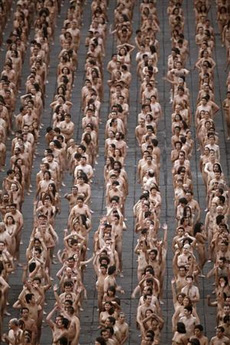 |
 |
 |
 Editorials | Issues | May 2007 Editorials | Issues | May 2007  
Why Not Get Naked?
 Manuel Roig-Franzia - Washington Post Manuel Roig-Franzia - Washington Post


| | Thousands of naked volunteers pose for U.S. photographer Spencer Tunick at Mexico City's Zocalo square, May 6, 2007. A record 18,000 people took off their clothes to pose for Tunick on Sunday in Mexico City's Zocalo square, the heart of the ancient Aztec empire. (Daniel Aguilar/Reuters) |
Carmen González stood prim and proper Sunday in the pre-dawn darkness of the Zócalo.

Her dark brown dress was neatly pressed, and she held her daughter´s hand tightly as the crowd pressed against them. This isn´t González´s "thing," hanging around at a crazy hour, preparing to get a little wild. But at the age of 50, she figured, "Why not?"

Why not get naked?

"I´m nervous," González told her 20-year-old daughter, Maria Oliva González, as a voice crackled over the loudspeaker.

But when Spencer Tunick, provocative photographer of the bare-bunned masses, gave the word, Carmen González did not hesitate. She shimmied out of that brown dress while her daughter was still fiddling with buttons.

And there it was. After a lifetime of acting demure, Carmen González was naked for all to see. And she was smiling.

Everyone else, it seemed, was smiling, too - an estimated 18,000 to 20,000 volunteer nude models hopping about in the morning chill. As the sun began to rise above the National Palace, they wriggled out of bluejeans, slipped off tank tops, kicked away shoes. A trio of college buddies sloughed off bathrobes and flip-flops. The crowd was mostly silent, except for the giggles.

Tunick, a New Yorker who was arrested multiple times when he began staging large-scale nude photo shoots in the early 1990s, has since become one of the world´s best-known photographers. He has posed nudes in front of a statue of Simon Bolivar in Caracas, Venezuela, filled the streets of Montreal and Sao Paulo, Brazil, with them and marched them through a London department store. He describes his work as "a symbol for freedom" and writes on his Web site that his nude photo event is "a mysterious morning ritual."

His Mexico City shoot was anticipated with all the hand-wringing that might be expected in this socially conservative country. Pundits and radio-show callers fretted about teen-agers and 20-somethings frolicking in a public raunch fest. Although the youngsters did show up in great numbers, the day seemed to belong to the Carmen Gonzálezes of this city, middle-age Mexicans who lived through their country´s authoritarian past and are reveling in a new sense of freedom.

"With this, I see us advancing. We´re moving toward more freedom of expression, more liberty," said Héctor Huerta, 40, a taxi driver, as he clasped the waist of his wife, Rosa Aguilar, also 40. "I could never imagine this happening in Mexico."


| | Spencer Tunick is known for his photographs that feature large numbers of nude people posed in artistic formations, often situated in urban locations. |
Tunick´s Mexico City debut wasn´t without bumps. His arrival was preceded by weighty philosophical battles about public nudity. The prominent Mexican art critic Raquel Tibol declared that Tunick´s photos would be "an antidote to Mexican prudishness," while the Spanish critic Román Gubern sniffed that the photographer´s work is "redundant" and "doesn´t appear artistic."

Tunick had hoped to stage his photos at Teotihuacán, the ancient ruins outside Mexico City where tourists flock to climb the Pyramids of the Sun and the Moon. But the Mexican government turned him down. His fallback was the city´s central square, known as the Zócalo.

But the square´s signature giant Mexican flag was not flying when the nudes arrived. And Tunick promised not to include the baroque National Cathedral, which sits on the square, in his shots.

In less than an hour, it was over, and thousands of shivering, naked bodies came bouncing back to the bags of clothes they´d left at the edge of the square.

They were dark-skinned indigenous people, pale men and women who trace their heritage from the Spanish conquistadors, light-brown mestizos. They were fat and skinny, tall and short. But stripped of their clothes and viewed from afar, they looked a lot alike.

They looked like Mexico. | 
 | |
 |



